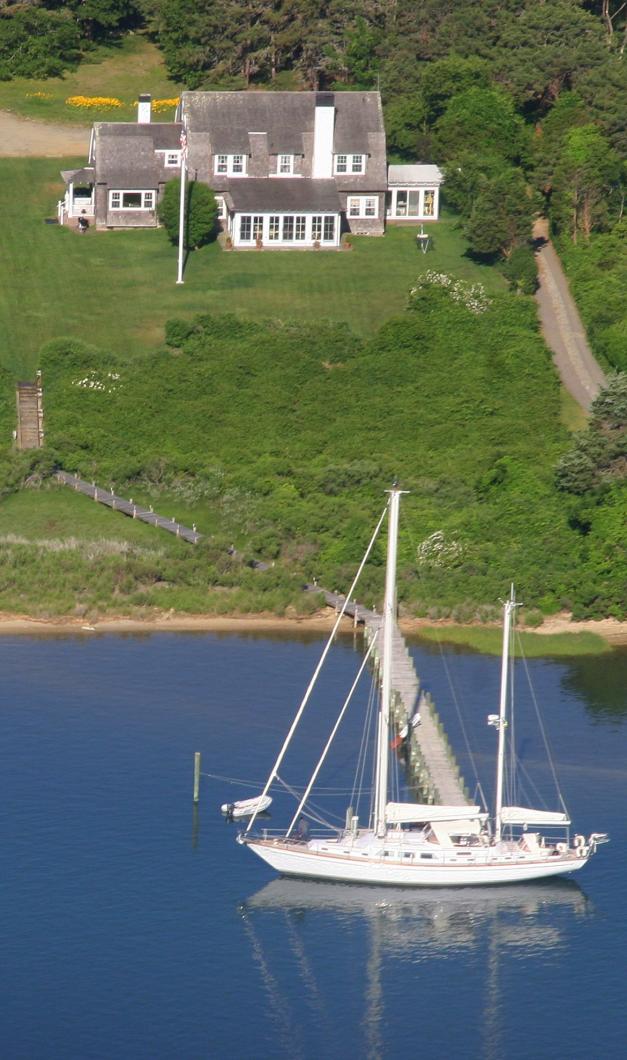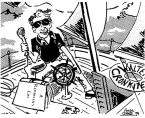The late Walter Cronkite’s Edgartown down-harbor home was sold this week for $11.3 million to longtime summer residents of Katama David and Karen Brush.
The Green Hollow property is located where the first white men settled for the winter on Martha’s Vineyard in 1632.
More recently, history was made at the six-bedroom, two-story Dutch colonial home with the gambrel roof when Dick Cavett set up cameras on the patio to interview the home’s then new owner, Mr. Cronkite, for what was the first talk show shot on the Vineyard, in 1974. The Cronkite springer spaniel Buzzy made his television debut in that segment.
The closing was Monday on a sale that was agreed to last fall.
“It is a piece of history,” said Tom Wallace, principal at Wallace and Co. Sotheby’s International, who had the listing. Sharon Purdy of Sandpiper Realty acted on the buyers’ behalf for the purchase.
“It’s one of the few properties that will really handle a deepwater vessel,” Mr. Wallace said, noting the listing had circulated globally and attracted diverse inquiries.
Mr. Cronkite, who died in August 2009, bought the 1.3-acre property and house in 1974.
The late CBS news anchor, who was at one time called the most trusted man in America was a familiar face of a different sort on the Vineyard, where he spent summers sailing off the Edgartown Harbor and generously loaned his time to countless fundraisers around the Island.
He also coauthored a series of nautical books with the Island artist Ray Ellis, all born aboard Mr. Cronkite’s 43-foot, ketch-rigged yacht, Wyntje, which was moored at the dock at 40 Green Hollow for many years.
“The other charming thing about the property,” Mr. Wallace said, “is the home itself, which is old world, New England understated.”
Mr. Wallace said many interested buyers looked at the property with the intent to start anew, but the Brushes were planning only minor adjustments on two wings, a small expansion “very much in keeping with the spirit” of the home.
“I’d been looking for some time to find a place on the water,” said Mr. Brush, a London-based global real estate fund manager. “I’d love to get a small sailboat.”
The Brushes have been summer visitors since the mid-1980s and purchased their Katama home, which is not waterfront, in 2001. Previously from New York, they have resided in London for the past 13 years. Mr. Brush said his family’s summer visits to the Vineyard get longer every year; “The family comes now as soon as school gets out, and I go back and forth,” he said.
He described planned renovations, including updating the bathrooms, enlarging the kitchen and building a separate garage. “Our intent is to keep the historic feel of the main house,” he said.
The Twanette Tharp architectural designs were approved by the Edgartown planning board late last year and include a new basement and two dormer windows in what was once Mr. Cronkite’s office.
Mark Lucier’s Katama Builders began the renovations Monday, Jan. 31, after Mrs. Brush was here to conclude the closing.
Mr. Wallace said that “of the other parties that were interested in the property, I think the Brushes’ desire to maintain what I would call the spirit of the existing home certainly had significant influence on the [Cronkite] family’s desire for them to get it, and having been on the Island and a good sense of being stewards made it an easy decision.”
Mr. Brush said the home fit the bill for his family’s wishes in all respects, and “that it is somewhat of a historic place in a bonus.
“We’re trying to preserve the character,” he said. They family hopes to be in the house for the summer in 2012.
The home was built in 1929 by the contractor Frank L. Norton for Tom T. Waller, who worked in New York city as president of a newsprint and paper company. Mr. Cronkite bought the home from one of Mr. Waller’s heirs, Tom Wuerth, who resided there in summers from 1968 on.
“The house is located in a spot that, according to Island legend, is the place where white men first settled for the winter on Martha’s Vineyard in 1632,” reads a Vineyard Gazette account of the previous sale. “At the Tower Hill graveyard there is a worn stone marking the grave of Robert Stone Sr., who died on March 2, 1689. The barely legible inscription reads: ‘Sixty rods southeast from this grave may be seen the ruins of the cellar of the house of the first white settlers who came to the Island — 1630.’”
Next to that place stands the Green Hollow house that now belongs to the Brushes.
Banks’ history of Martha’s Vineyard makes reference to this settlement that allegedly took place before Thomas Mayhew purchased the proprietorship of the Island in 1642. The book quotes a letter describing the arrival of John Pease’s ship near Stony Point in the fall of 1632. The letter tells that four men with their families, including John Pease, disembarked from the vessel and were met by friendly but cautious Indians. The Indians led them to “the Green Hollow, beyond the old Burial Ground where the Indians obtained both fish and fowl. In this Hollow the men dug caves — the places are still plainly seen on the North side of the Hollow — and spent the winter.”






Comments (5)
Comments
Comment policy »